-
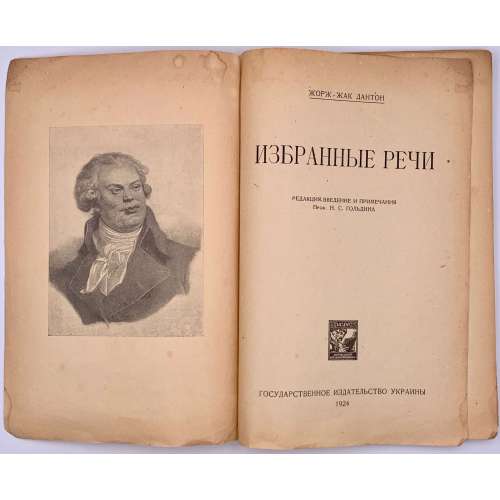 Title page: ЖОРЖ-ЖАК ДАНТОН | ИЗБРАННЫЕ РЕЧИ | РЕДАКЦИЯ, ВВЕДЕНИЕ И ПРИМЕЧАНИЯ | Проф. Н. С. ГОЛЬДИНА | {publisher’s device} | ГОСУДАРСТВЕННОЕ ИЗДАТЕЛЬСТВО УКРАИНЫ | 1924 Lacking wrappers, [2] – blank / frontispiece portrait of Danton, [2] t.p., / imprint, v-xviii, [2] –f.t / blank, 1-111 [112], collation: π2 *8 1-78. Danton, Georges Jacques [Дантон, Жорж Жак] (French, 1759 – 1794). Гольдин, Николай Сергеевич (Ukrainian-Jewish, 1877 – after 1924). Translator unknown.
Title page: ЖОРЖ-ЖАК ДАНТОН | ИЗБРАННЫЕ РЕЧИ | РЕДАКЦИЯ, ВВЕДЕНИЕ И ПРИМЕЧАНИЯ | Проф. Н. С. ГОЛЬДИНА | {publisher’s device} | ГОСУДАРСТВЕННОЕ ИЗДАТЕЛЬСТВО УКРАИНЫ | 1924 Lacking wrappers, [2] – blank / frontispiece portrait of Danton, [2] t.p., / imprint, v-xviii, [2] –f.t / blank, 1-111 [112], collation: π2 *8 1-78. Danton, Georges Jacques [Дантон, Жорж Жак] (French, 1759 – 1794). Гольдин, Николай Сергеевич (Ukrainian-Jewish, 1877 – after 1924). Translator unknown. -
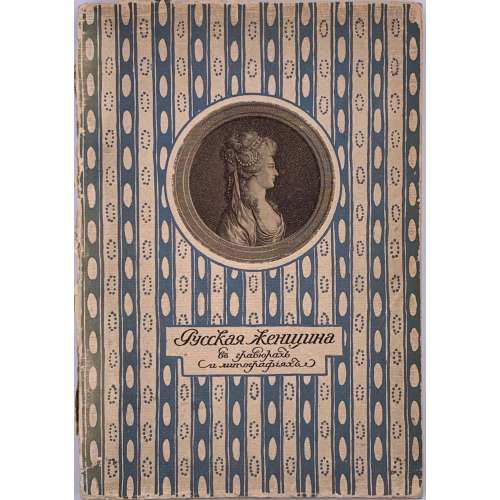 Description: Softcover volume in publisher’s pictorial wrappers, with a b/w medallion portrait and lettering in a frame over geometrical pattern in blue to front; 23 x 16.3 cm, collated 8vo. Title-page: РУССКАЯ ЖЕНЩИНА | ВЪ | ГРАВЮРАХЪ И ЛИТОГРАФIЯХЪ | – | ВЫСТАВКА ПОРТРЕТОВЪ | – | КРУЖОКЪ ЛЮБИТЕЛЕЙ | РУССКИХЪ ИЗЯЩНЫХЪ ИЗДАНIЙ | 1911 || Collation: 1-48, last blank, total 32 leaves plus 15 plates (collotype reproductions) with tissue guards, incl. frontispiece, and a few headpieces; catalogue with 180 entries. Pagination: [1-6] 7-63 [64] [2], total 64 pages, ils. Incl. article "Русская женщина в искусстве" барона Н. Н. Врангеля. Барон Николай Николаевич Врангель (Russian, 1880 – 1915)
Description: Softcover volume in publisher’s pictorial wrappers, with a b/w medallion portrait and lettering in a frame over geometrical pattern in blue to front; 23 x 16.3 cm, collated 8vo. Title-page: РУССКАЯ ЖЕНЩИНА | ВЪ | ГРАВЮРАХЪ И ЛИТОГРАФIЯХЪ | – | ВЫСТАВКА ПОРТРЕТОВЪ | – | КРУЖОКЪ ЛЮБИТЕЛЕЙ | РУССКИХЪ ИЗЯЩНЫХЪ ИЗДАНIЙ | 1911 || Collation: 1-48, last blank, total 32 leaves plus 15 plates (collotype reproductions) with tissue guards, incl. frontispiece, and a few headpieces; catalogue with 180 entries. Pagination: [1-6] 7-63 [64] [2], total 64 pages, ils. Incl. article "Русская женщина в искусстве" барона Н. Н. Врангеля. Барон Николай Николаевич Врангель (Russian, 1880 – 1915) -
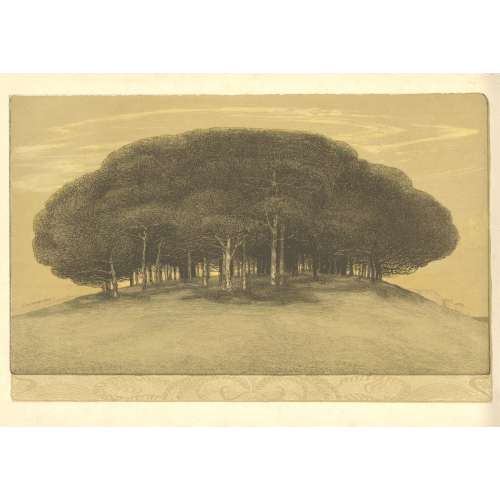 Colour (tone) lithography, image 268 x 410 mm, sheet 317 x 470 mm; signed on bottom-left of the image “Pelikan 1905”, and pencil ms inscription: E. Pelikan to the lower-right corner of the sheet. Contributor: Emilie Mediz-Pelikan (Austrian, 1861 – 1908) – artist. Seller's description: Austrian-German painter and graphic artist. Emilie Mediz-Pelikan was born in Vöcklabruck in 1861. She studied at the Vienna Academy and followed her teacher Albert Zimmermann to Salzburg and in 1885 to Munich. In 1891 she married the painter and graphic artist Karl Mediz (1868 - 1945), with whom she lived in Vienna and from 1894 in Dresden. She was in contact with the Dachau Artists' Colony and went on study trips to Paris, Belgium, Hungary and Italy. In the Dachau artists' colony she was friends with Adolf Hölzel and Fritz von Uhde. In 1889 and 1890 she spent time in Paris and in the Belgian artists' colony Knokke. In 1898 she was represented at the first art exhibition of the Vienna Secession, and in 1901 at the International Art Exhibition in Dresden. In 1903 she and her husband had a group exhibition, at the Hagenbund in Vienna. In 1904, she showed graphic works at the Dresden royal court art dealer Richter, and in 1905 and 1906 she exhibited at the Berlin Künstlerhaus. It was not until around 1900 that she achieved her artistic breakthrough with her landscape paintings. Since the estate of the artist, who died prematurely in Dresden in 1908, was lost in the former GDR until the 1980s, it was quite late that the artist was rediscovered and revalued both in Austrian art history and on the art market. In 1986, the first major exhibitions took place at the Upper Austrian State Museum and the University of Applied Arts in Vienna, followed by numerous smaller exhibitions in private galleries in Vienna, Linz and Munich. The artist received recognition during her lifetime from numerous prominent fellow painters as well as from the art critic Ludwig Hevesi. Together with Tina Blau, Herbert Boeckl, Marie Egner, Theodor von Hörmann, Franz Jaschke, Eugen Jettel, Ludwig Heinrich Jungnickel, Rudolf Junk, Gustav Klimt, Oskar Kokoschka, Johann Victor Krämer, Heinrich Kühn, Carl Moll, Rudolf Quittner, Rudolf Ribarz, Emil Jakob Schindler, Max Suppantschitsch, Max Weiler, Olga Wisinger-Florian and Alfred Zoff, she was a protagonist of the reception of Impressionism in Austria. This style went down in Austrian art history under the term "Stimmungsimpressionismus".
Colour (tone) lithography, image 268 x 410 mm, sheet 317 x 470 mm; signed on bottom-left of the image “Pelikan 1905”, and pencil ms inscription: E. Pelikan to the lower-right corner of the sheet. Contributor: Emilie Mediz-Pelikan (Austrian, 1861 – 1908) – artist. Seller's description: Austrian-German painter and graphic artist. Emilie Mediz-Pelikan was born in Vöcklabruck in 1861. She studied at the Vienna Academy and followed her teacher Albert Zimmermann to Salzburg and in 1885 to Munich. In 1891 she married the painter and graphic artist Karl Mediz (1868 - 1945), with whom she lived in Vienna and from 1894 in Dresden. She was in contact with the Dachau Artists' Colony and went on study trips to Paris, Belgium, Hungary and Italy. In the Dachau artists' colony she was friends with Adolf Hölzel and Fritz von Uhde. In 1889 and 1890 she spent time in Paris and in the Belgian artists' colony Knokke. In 1898 she was represented at the first art exhibition of the Vienna Secession, and in 1901 at the International Art Exhibition in Dresden. In 1903 she and her husband had a group exhibition, at the Hagenbund in Vienna. In 1904, she showed graphic works at the Dresden royal court art dealer Richter, and in 1905 and 1906 she exhibited at the Berlin Künstlerhaus. It was not until around 1900 that she achieved her artistic breakthrough with her landscape paintings. Since the estate of the artist, who died prematurely in Dresden in 1908, was lost in the former GDR until the 1980s, it was quite late that the artist was rediscovered and revalued both in Austrian art history and on the art market. In 1986, the first major exhibitions took place at the Upper Austrian State Museum and the University of Applied Arts in Vienna, followed by numerous smaller exhibitions in private galleries in Vienna, Linz and Munich. The artist received recognition during her lifetime from numerous prominent fellow painters as well as from the art critic Ludwig Hevesi. Together with Tina Blau, Herbert Boeckl, Marie Egner, Theodor von Hörmann, Franz Jaschke, Eugen Jettel, Ludwig Heinrich Jungnickel, Rudolf Junk, Gustav Klimt, Oskar Kokoschka, Johann Victor Krämer, Heinrich Kühn, Carl Moll, Rudolf Quittner, Rudolf Ribarz, Emil Jakob Schindler, Max Suppantschitsch, Max Weiler, Olga Wisinger-Florian and Alfred Zoff, she was a protagonist of the reception of Impressionism in Austria. This style went down in Austrian art history under the term "Stimmungsimpressionismus". -
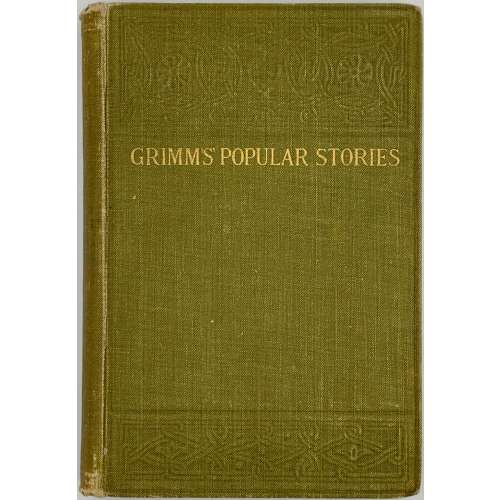 Title: OXFORD EDITION | POPULAR STORIES | COLLECTED BY | THE BROTHERS GRIMM | A REPRINT OF THE FIRST ENGLISH EDITION | WITH TWENTY-TWO ILLUSTRATIONS | BY GEORGE CRUIKSHANK | {publisher’s device} | HENRY FROWDE | LONDON, EDINBURGH, GLASGOW | NEW YORK AND TORONTO | 1905 || Pagination: [i, ii] – frontis., [iii-iv]– t.p. / imprint. [v] – preface, vi-xvii [xviii blank], [2] [1] 2-403 [404], plates included in pagination, pp. 379-403 – notes. Collation: a8 b2 B-Z8 Aa-Cc8 Dd2. Binding:1 9 x 13 cm, olive green cloth blind-stamped in art nouveau style and lettered in gilt to cover and spine: GRIMMS’ POPULAR STORIES. Aubergine pencil inscription to front pastedown: C. Grant Robertson | All Souls | 1905: Provenance: Sir Charles Grant Robertson CVO (British, 1869 – 1948) who was a British academic historian, a Fellow of All Souls College, Oxford, and Vice-chancellor of the University of Birmingham.
Title: OXFORD EDITION | POPULAR STORIES | COLLECTED BY | THE BROTHERS GRIMM | A REPRINT OF THE FIRST ENGLISH EDITION | WITH TWENTY-TWO ILLUSTRATIONS | BY GEORGE CRUIKSHANK | {publisher’s device} | HENRY FROWDE | LONDON, EDINBURGH, GLASGOW | NEW YORK AND TORONTO | 1905 || Pagination: [i, ii] – frontis., [iii-iv]– t.p. / imprint. [v] – preface, vi-xvii [xviii blank], [2] [1] 2-403 [404], plates included in pagination, pp. 379-403 – notes. Collation: a8 b2 B-Z8 Aa-Cc8 Dd2. Binding:1 9 x 13 cm, olive green cloth blind-stamped in art nouveau style and lettered in gilt to cover and spine: GRIMMS’ POPULAR STORIES. Aubergine pencil inscription to front pastedown: C. Grant Robertson | All Souls | 1905: Provenance: Sir Charles Grant Robertson CVO (British, 1869 – 1948) who was a British academic historian, a Fellow of All Souls College, Oxford, and Vice-chancellor of the University of Birmingham. -
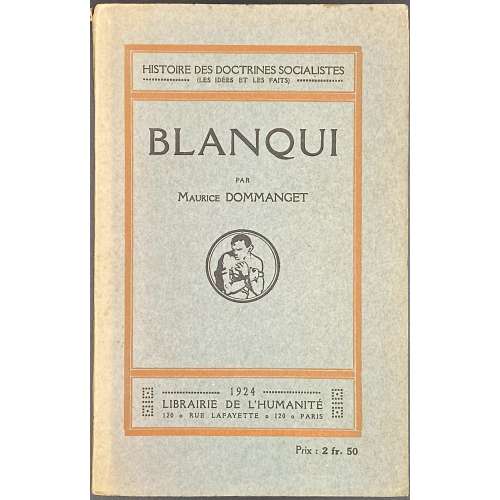 Front wrapper: In the three-compartment orange frame: 1st compartment: HISTOIRE DES DOCTRINES SOCIALISTES | *** (LES IDÉES ET LES FAITS) *** | 2nd compartment: BLANQUI | PAR | Maurice DOMMANGET | {circular device} | 3rd compartment: *** 1924 *** | LIBRAIRIE DE L'HUMANITÉ | 120 • RUE LAFAYETTE • 120 PARIS | Under the frame : Prix : 2 fr. 50 || Title page: HISTOIRE DES DOCTRINES SOCIALISTES | *** (LES IDÉES ET LES FAITS) *** | BLANQUI | PAR Maurice DOMMANGET | {device in a circle} | *** 1924 *** | LIBRAIRIE DE L'HUMANITÉ | 120 • RUE LAFAYETTE • 120 PARIS || Back wrapper: Advert. in an orange frame. Pagination: wrappers included in pagination ; [1-5] 6-95 [96-98] (total 49 leaves incl. wrappers). Collation: wrappers not included in collation: [1]-68. Binding: 18.5 x 12 cm; publisher’s blue wrappers with an orange frame, black lettering to covers and spine; uncut. Russian translation: LIB-2747.2021
Front wrapper: In the three-compartment orange frame: 1st compartment: HISTOIRE DES DOCTRINES SOCIALISTES | *** (LES IDÉES ET LES FAITS) *** | 2nd compartment: BLANQUI | PAR | Maurice DOMMANGET | {circular device} | 3rd compartment: *** 1924 *** | LIBRAIRIE DE L'HUMANITÉ | 120 • RUE LAFAYETTE • 120 PARIS | Under the frame : Prix : 2 fr. 50 || Title page: HISTOIRE DES DOCTRINES SOCIALISTES | *** (LES IDÉES ET LES FAITS) *** | BLANQUI | PAR Maurice DOMMANGET | {device in a circle} | *** 1924 *** | LIBRAIRIE DE L'HUMANITÉ | 120 • RUE LAFAYETTE • 120 PARIS || Back wrapper: Advert. in an orange frame. Pagination: wrappers included in pagination ; [1-5] 6-95 [96-98] (total 49 leaves incl. wrappers). Collation: wrappers not included in collation: [1]-68. Binding: 18.5 x 12 cm; publisher’s blue wrappers with an orange frame, black lettering to covers and spine; uncut. Russian translation: LIB-2747.2021 -
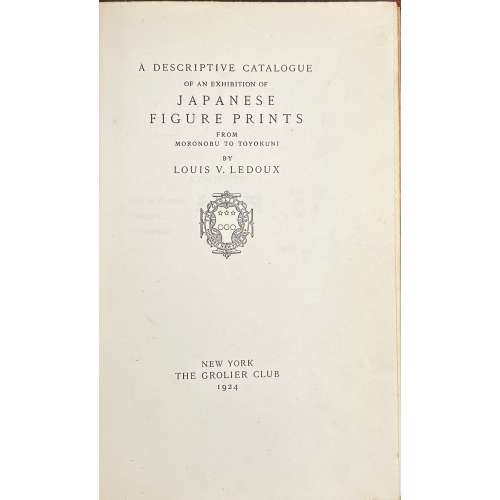 Hardcover, 24 x 16 cm, bound in quarter black calf over marbled boards, raised bands and gilt lettering to spine, printed on Van Gelder Zonen laid paper with wide margins, bottom and fore edge untrimmed, pp. [i-viii] ix-xiv, [2] 3-89 [90], total 104 pages, two flyleaves, frontispiece in colour with captioned tissue guard, and 28 b/w plates; total 83 leaves. Title-page: A DESCRIPTIVE CATALOGUE | OF AN EXHIBITION OF | JAPANESE | FIGURE PRINTS | FROM | MORONOBU TO TOYOKUNI | BY | LOUIS V. LEDOUX | {publisher’s device} | NEW YORK | THE GROLIER CLUB | 1924 || Edition: 1st edition limited to 300 copies on Van Gelder Zonen paper in April, 2024. Exhibition from January 25 to March 3, 1923, at the Grolier club. Library of Congress Control Number: 23009175 OCLC Number: 2583847 Louis Vernon Ledoux (American, 1880 – 1948)
Hardcover, 24 x 16 cm, bound in quarter black calf over marbled boards, raised bands and gilt lettering to spine, printed on Van Gelder Zonen laid paper with wide margins, bottom and fore edge untrimmed, pp. [i-viii] ix-xiv, [2] 3-89 [90], total 104 pages, two flyleaves, frontispiece in colour with captioned tissue guard, and 28 b/w plates; total 83 leaves. Title-page: A DESCRIPTIVE CATALOGUE | OF AN EXHIBITION OF | JAPANESE | FIGURE PRINTS | FROM | MORONOBU TO TOYOKUNI | BY | LOUIS V. LEDOUX | {publisher’s device} | NEW YORK | THE GROLIER CLUB | 1924 || Edition: 1st edition limited to 300 copies on Van Gelder Zonen paper in April, 2024. Exhibition from January 25 to March 3, 1923, at the Grolier club. Library of Congress Control Number: 23009175 OCLC Number: 2583847 Louis Vernon Ledoux (American, 1880 – 1948) -
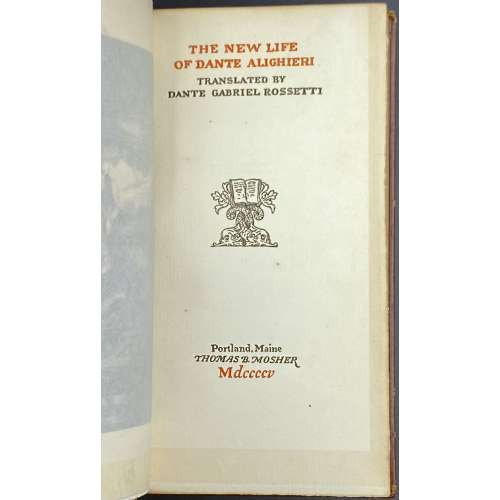 Title: THE NEW LIFE | OF DANTE ALIGHIERI | TRANSLATED BY | DANTE GABRIEL ROSSETTI | {Publisher's device} | Portland, Maine | THOMAS B. MOSHER | Mdccccv Pagination: Ffl [i-viii] ix-xii [xiii] [xiv blank], [1, 2] 3-97 [98] bfl; frontis. w/guard; Note: “This fourth edition on Van Gelder paper consists of 925 copies”. Binding: Hardcover, 18.2 x 10.2 cm, full brown morocco possibly by Sangorski & Sutcliffe, with embossed design elements, raised bands, gilt lettering to spine, TMG, other untrimmed; printed on laid paper with watermark.
Title: THE NEW LIFE | OF DANTE ALIGHIERI | TRANSLATED BY | DANTE GABRIEL ROSSETTI | {Publisher's device} | Portland, Maine | THOMAS B. MOSHER | Mdccccv Pagination: Ffl [i-viii] ix-xii [xiii] [xiv blank], [1, 2] 3-97 [98] bfl; frontis. w/guard; Note: “This fourth edition on Van Gelder paper consists of 925 copies”. Binding: Hardcover, 18.2 x 10.2 cm, full brown morocco possibly by Sangorski & Sutcliffe, with embossed design elements, raised bands, gilt lettering to spine, TMG, other untrimmed; printed on laid paper with watermark. -
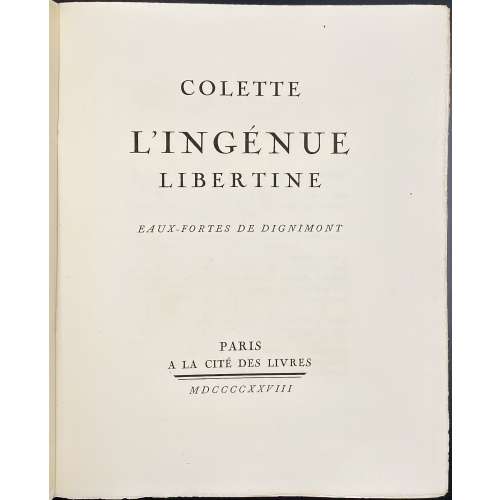 Title-page: COLETTE | L'INGÉNUE | LIBERTINE | EAUX-FORTES DE DIGNIMONT | PARIS | A LA CITÉ DES LIVRES | — | MDCCCCXXVIII || Cover (front wrapper): Similar to t.p. but in red and black: COLETTE | L'INGÉNUE | LIBERTINE | EAUX-FORTES DE DIGNIMONT | PARIS | A LA CITÉ DES LIVRES | — | MDCCCCXXVIII || Description: French flapped wrapper in a red marbled double slipcase with lettered paper label to spine, 29.5 x 23 x 5.5 cm, in-4to, leaves 28 x 22.5 cm. Collation: π4 (π1 in wrapper, π2 blank, π3 h.t. / limitation, π4 t.p. / blank, 1-304, χ2 (χ1 blank, χ2 in wrapper), plus 15 plates extraneous to collation, with tissue-guards, incl. frontispiece. Pagination: [8] [1] 2-237 [238] [6], ils. Plates: 15 etchings in sepia by André Dignimont. Enrichment: Additional full suite of 15 plates in sanguine. Limitation: Edition is limited to 215 copies, 150 of them printed on thick wove paper (Vélin de Hollande), numbered 41 – 190, with one additional suite of plates. This copy is № 168. Printed on October 14, 1928. Contributors: Sidonie-Gabrielle Colette [a.k.a. Colette] (French, 1873 – 1954) André Dignimont (French, 1891 – 1965) – artist. La cité des livres – publishers. R. Coulouma (Argenteuil, director H. Barthélemy) – printer, typography. Atelier de la Roseraie – printer, etchings.
Title-page: COLETTE | L'INGÉNUE | LIBERTINE | EAUX-FORTES DE DIGNIMONT | PARIS | A LA CITÉ DES LIVRES | — | MDCCCCXXVIII || Cover (front wrapper): Similar to t.p. but in red and black: COLETTE | L'INGÉNUE | LIBERTINE | EAUX-FORTES DE DIGNIMONT | PARIS | A LA CITÉ DES LIVRES | — | MDCCCCXXVIII || Description: French flapped wrapper in a red marbled double slipcase with lettered paper label to spine, 29.5 x 23 x 5.5 cm, in-4to, leaves 28 x 22.5 cm. Collation: π4 (π1 in wrapper, π2 blank, π3 h.t. / limitation, π4 t.p. / blank, 1-304, χ2 (χ1 blank, χ2 in wrapper), plus 15 plates extraneous to collation, with tissue-guards, incl. frontispiece. Pagination: [8] [1] 2-237 [238] [6], ils. Plates: 15 etchings in sepia by André Dignimont. Enrichment: Additional full suite of 15 plates in sanguine. Limitation: Edition is limited to 215 copies, 150 of them printed on thick wove paper (Vélin de Hollande), numbered 41 – 190, with one additional suite of plates. This copy is № 168. Printed on October 14, 1928. Contributors: Sidonie-Gabrielle Colette [a.k.a. Colette] (French, 1873 – 1954) André Dignimont (French, 1891 – 1965) – artist. La cité des livres – publishers. R. Coulouma (Argenteuil, director H. Barthélemy) – printer, typography. Atelier de la Roseraie – printer, etchings. -
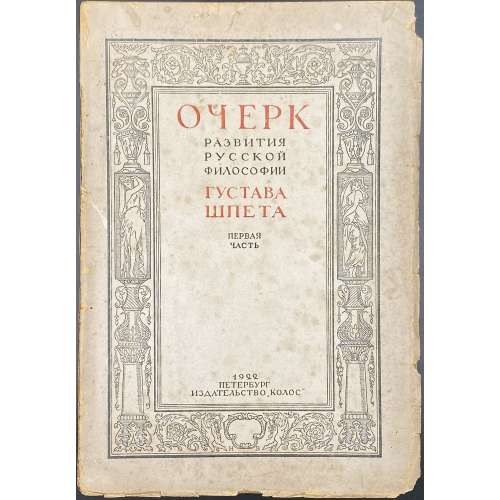 Paperback, 25 x 17 cm, publisher’s wrappers with red and black lettering in a pictorial frame by Vysheslavstev; pp.: [i-vii] viii-xv [xvi blank], [1-5] 6-348 [4]; collated 8vo: π8 1-228, total 184 leaves, 368 pages; gatherings 1-22 uncut. Because the author was banned, lettering on the spine was covered by a glued strip of blank paper; only the year 1922 was left visible. Front wrapper: ОЧЕРК | РАЗВИТИЯ | РУССКОЙ | ФИЛОСОФИИ | ГУСТАВА | ШПЕТА | ПЕРВАЯ | ЧАСТЬ | 1922 | ПЕТЕРБУРГ | ИЗДАТЕЛЬСТВО “КОЛОС” || Title-page: similar lettering in black only with no frame. Design of the front wrapper and the publisher’s device (π1) by Николай Николаевич Вышеславцев [N. Vysheslavstev] (Russian, 1890 – 1952). Title: Sketch on the development of Russian philosophy, Part one. [Part two was never published]. Author: Густав Густавович Шпет [Gustav Shpet] (Russian, 1879 – 1937) – executed by fire squad on 16 November 1937.
Paperback, 25 x 17 cm, publisher’s wrappers with red and black lettering in a pictorial frame by Vysheslavstev; pp.: [i-vii] viii-xv [xvi blank], [1-5] 6-348 [4]; collated 8vo: π8 1-228, total 184 leaves, 368 pages; gatherings 1-22 uncut. Because the author was banned, lettering on the spine was covered by a glued strip of blank paper; only the year 1922 was left visible. Front wrapper: ОЧЕРК | РАЗВИТИЯ | РУССКОЙ | ФИЛОСОФИИ | ГУСТАВА | ШПЕТА | ПЕРВАЯ | ЧАСТЬ | 1922 | ПЕТЕРБУРГ | ИЗДАТЕЛЬСТВО “КОЛОС” || Title-page: similar lettering in black only with no frame. Design of the front wrapper and the publisher’s device (π1) by Николай Николаевич Вышеславцев [N. Vysheslavstev] (Russian, 1890 – 1952). Title: Sketch on the development of Russian philosophy, Part one. [Part two was never published]. Author: Густав Густавович Шпет [Gustav Shpet] (Russian, 1879 – 1937) – executed by fire squad on 16 November 1937. -
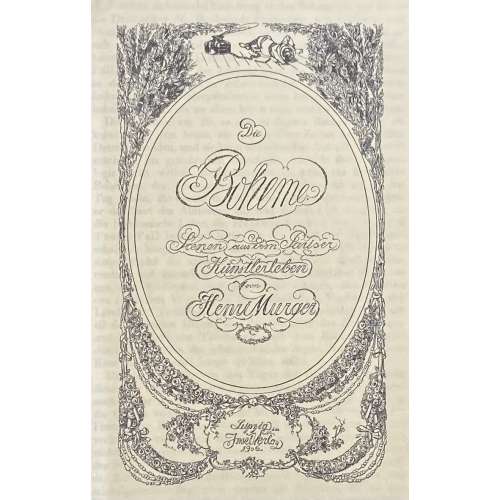 Pictorial title by von Bayros: Die | Bohème. | Scenen aus dem Pariser | Künstlerleben | von | Henri Murger | Leipzig im | InselVerlag | 1906. | F. Bayros || Pagination: [2] – pictorial frontispiece, [2] – pictorial t.p., 1-280 [2] – inhalt, [2] – colophon, [2] – blank, + 4 plates drawn by Franz von Bayros and reproduced as photogravure, with guards. Binding: 23.5 x 15.5 cm, cream parchment, raised bands, gilt-lettered orange morocco label to spine; text printed on laid paper (Linden Paper watermark), untrimmed, illustrations on wove paper as photogravure. Bookplate: “Ex libris Walter Schniewind” engraved by C. L. Becker. Original title: Henry Murger. Scenes De La Vie De Boheme. — Paris: Michel Lévy frères, 1851. Tirage: 50 copies on laid paper, of which this is № 14 (per Sarkowski: 50 numerierte Ex. auf Bütten. Pergament mit Goldschnitt). Author: Murger, Henri [Murger, Louis-Henri, Henry] (French, 1822 – 1861). Translator: Grove, Frederick Philip [Greve, Felix Paul] (German-Canadian, 1879 – 1948). Illustrator: Bayros, Franz von (Austrian, 1866 – 1924). Printer: Drugulin, Wilhelm Eduard (German, 1822 – 1879); Offizin W. Drugulin (Leipzig). Provenance: Schniewind, Walter (German, 1870 – 1927). Catalogue raisonné: Heinz Sarkowski (1999): № 1175 VA, p. 195; Bayros Zeichnungen, pp. 43-46.
Pictorial title by von Bayros: Die | Bohème. | Scenen aus dem Pariser | Künstlerleben | von | Henri Murger | Leipzig im | InselVerlag | 1906. | F. Bayros || Pagination: [2] – pictorial frontispiece, [2] – pictorial t.p., 1-280 [2] – inhalt, [2] – colophon, [2] – blank, + 4 plates drawn by Franz von Bayros and reproduced as photogravure, with guards. Binding: 23.5 x 15.5 cm, cream parchment, raised bands, gilt-lettered orange morocco label to spine; text printed on laid paper (Linden Paper watermark), untrimmed, illustrations on wove paper as photogravure. Bookplate: “Ex libris Walter Schniewind” engraved by C. L. Becker. Original title: Henry Murger. Scenes De La Vie De Boheme. — Paris: Michel Lévy frères, 1851. Tirage: 50 copies on laid paper, of which this is № 14 (per Sarkowski: 50 numerierte Ex. auf Bütten. Pergament mit Goldschnitt). Author: Murger, Henri [Murger, Louis-Henri, Henry] (French, 1822 – 1861). Translator: Grove, Frederick Philip [Greve, Felix Paul] (German-Canadian, 1879 – 1948). Illustrator: Bayros, Franz von (Austrian, 1866 – 1924). Printer: Drugulin, Wilhelm Eduard (German, 1822 – 1879); Offizin W. Drugulin (Leipzig). Provenance: Schniewind, Walter (German, 1870 – 1927). Catalogue raisonné: Heinz Sarkowski (1999): № 1175 VA, p. 195; Bayros Zeichnungen, pp. 43-46. -
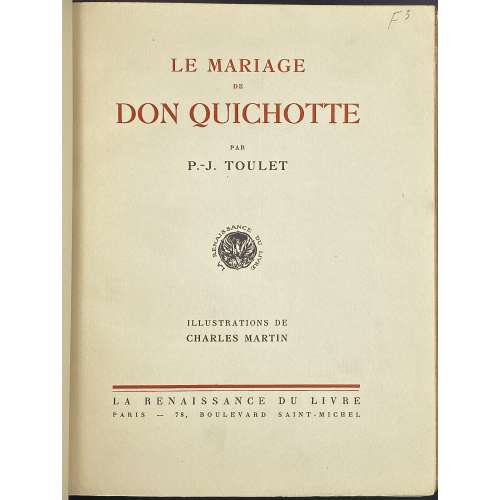 Description: One volume, 25.5 x 19.8 cm, bound in ochre morocco, raised bands, gilt lettering to spine, gilt fillet inside, marbled endpapers, T.E.G., printed on wove paper watermarked “Lafuma”, original wrappers and spine bound in; in a slipcase 26 x 20 cm. Front wrapper and title-page (red and black): LE MARIAGE | DE | DON QUICHOTTE | PAR | P.-J. TOULET | {publisher’s device} | ILLUSTRATIONS DE | (CHARLES) MARTIN | — | LA RENAISSANCE DU LIVRE | PARIS — 78, BOULEVARD SAINT-MICHEL || Collation: two blank leaves, front wrapper, π4 (blank, h.t./limitation, t.p., preface), 1-274, back wrapper, spine, two blank leaves, 112 leaves between the wrappers plus 9 plates extraneous to collation, incl. frontispiece – stencil-coloured photogravures after Charles Martin. Pagination: [8] 1-210 [2] [4], total 224 pages between the wrappers, ils. Limitation: Edition limited to 775 copies, of which 1 copy on Vieux Japon (№ 1), 24 on Japon Imperial (№2-25), and 750 on Vélin Lafuma (№ 26-775). This copy is № 625. Colophon: Printed on November 15, 1922 – text by Coulouma (Argeneuil), director H. Barthélemy, photogravures by Héliogravure de Schutzenberger (Paris), coloured by Charpentier. Contributors: Paul-Jean Toulet (French, 1867 – 1920) – author. Charles Martin (French, 1884 – 1934) – artist. Léon Maurice Schützenberger (French, 1863 – 1950)
Description: One volume, 25.5 x 19.8 cm, bound in ochre morocco, raised bands, gilt lettering to spine, gilt fillet inside, marbled endpapers, T.E.G., printed on wove paper watermarked “Lafuma”, original wrappers and spine bound in; in a slipcase 26 x 20 cm. Front wrapper and title-page (red and black): LE MARIAGE | DE | DON QUICHOTTE | PAR | P.-J. TOULET | {publisher’s device} | ILLUSTRATIONS DE | (CHARLES) MARTIN | — | LA RENAISSANCE DU LIVRE | PARIS — 78, BOULEVARD SAINT-MICHEL || Collation: two blank leaves, front wrapper, π4 (blank, h.t./limitation, t.p., preface), 1-274, back wrapper, spine, two blank leaves, 112 leaves between the wrappers plus 9 plates extraneous to collation, incl. frontispiece – stencil-coloured photogravures after Charles Martin. Pagination: [8] 1-210 [2] [4], total 224 pages between the wrappers, ils. Limitation: Edition limited to 775 copies, of which 1 copy on Vieux Japon (№ 1), 24 on Japon Imperial (№2-25), and 750 on Vélin Lafuma (№ 26-775). This copy is № 625. Colophon: Printed on November 15, 1922 – text by Coulouma (Argeneuil), director H. Barthélemy, photogravures by Héliogravure de Schutzenberger (Paris), coloured by Charpentier. Contributors: Paul-Jean Toulet (French, 1867 – 1920) – author. Charles Martin (French, 1884 – 1934) – artist. Léon Maurice Schützenberger (French, 1863 – 1950) -
 Colour (tone) lithography, image 396 x 508 mm, sheet 532 x 654 mm; before signature, undated; pencil ms inscription: Föhrenhain — E. Pelikan / 200M to the lower-right corner of the sheet. Contributor: Emilie Mediz-Pelikan (Austrian, 1861 – 1908) – artist. Seller's description: Austrian-German painter and graphic artist. Emilie Mediz-Pelikan was born in Vöcklabruck in 1861. She studied at the Vienna Academy and followed her teacher Albert Zimmermann to Salzburg and in 1885 to Munich. In 1891 she married the painter and graphic artist Karl Mediz (1868 - 1945), with whom she lived in Vienna and from 1894 in Dresden. She was in contact with the Dachau Artists' Colony and went on study trips to Paris, Belgium, Hungary and Italy. In the Dachau artists' colony she was friends with Adolf Hölzel and Fritz von Uhde. In 1889 and 1890 she spent time in Paris and in the Belgian artists' colony Knokke. In 1898 she was represented at the first art exhibition of the Vienna Secession, and in 1901 at the International Art Exhibition in Dresden. In 1903 she and her husband had a group exhibition, at the Hagenbund in Vienna. In 1904, she showed graphic works at the Dresden royal court art dealer Richter, and in 1905 and 1906 she exhibited at the Berlin Künstlerhaus. It was not until around 1900 that she achieved her artistic breakthrough with her landscape paintings. Since the estate of the artist, who died prematurely in Dresden in 1908, was lost in the former GDR until the 1980s, it was quite late that the artist was rediscovered and revalued both in Austrian art history and on the art market. In 1986, the first major exhibitions took place at the Upper Austrian State Museum and the University of Applied Arts in Vienna, followed by numerous smaller exhibitions in private galleries in Vienna, Linz and Munich. The artist received recognition during her lifetime from numerous prominent fellow painters as well as from the art critic Ludwig Hevesi. Together with Tina Blau, Herbert Boeckl, Marie Egner, Theodor von Hörmann, Franz Jaschke, Eugen Jettel, Ludwig Heinrich Jungnickel, Rudolf Junk, Gustav Klimt, Oskar Kokoschka, Johann Victor Krämer, Heinrich Kühn, Carl Moll, Rudolf Quittner, Rudolf Ribarz, Emil Jakob Schindler, Max Suppantschitsch, Max Weiler, Olga Wisinger-Florian and Alfred Zoff, she was a protagonist of the reception of Impressionism in Austria. This style went down in Austrian art history under the term "Stimmungsimpressionismus".
Colour (tone) lithography, image 396 x 508 mm, sheet 532 x 654 mm; before signature, undated; pencil ms inscription: Föhrenhain — E. Pelikan / 200M to the lower-right corner of the sheet. Contributor: Emilie Mediz-Pelikan (Austrian, 1861 – 1908) – artist. Seller's description: Austrian-German painter and graphic artist. Emilie Mediz-Pelikan was born in Vöcklabruck in 1861. She studied at the Vienna Academy and followed her teacher Albert Zimmermann to Salzburg and in 1885 to Munich. In 1891 she married the painter and graphic artist Karl Mediz (1868 - 1945), with whom she lived in Vienna and from 1894 in Dresden. She was in contact with the Dachau Artists' Colony and went on study trips to Paris, Belgium, Hungary and Italy. In the Dachau artists' colony she was friends with Adolf Hölzel and Fritz von Uhde. In 1889 and 1890 she spent time in Paris and in the Belgian artists' colony Knokke. In 1898 she was represented at the first art exhibition of the Vienna Secession, and in 1901 at the International Art Exhibition in Dresden. In 1903 she and her husband had a group exhibition, at the Hagenbund in Vienna. In 1904, she showed graphic works at the Dresden royal court art dealer Richter, and in 1905 and 1906 she exhibited at the Berlin Künstlerhaus. It was not until around 1900 that she achieved her artistic breakthrough with her landscape paintings. Since the estate of the artist, who died prematurely in Dresden in 1908, was lost in the former GDR until the 1980s, it was quite late that the artist was rediscovered and revalued both in Austrian art history and on the art market. In 1986, the first major exhibitions took place at the Upper Austrian State Museum and the University of Applied Arts in Vienna, followed by numerous smaller exhibitions in private galleries in Vienna, Linz and Munich. The artist received recognition during her lifetime from numerous prominent fellow painters as well as from the art critic Ludwig Hevesi. Together with Tina Blau, Herbert Boeckl, Marie Egner, Theodor von Hörmann, Franz Jaschke, Eugen Jettel, Ludwig Heinrich Jungnickel, Rudolf Junk, Gustav Klimt, Oskar Kokoschka, Johann Victor Krämer, Heinrich Kühn, Carl Moll, Rudolf Quittner, Rudolf Ribarz, Emil Jakob Schindler, Max Suppantschitsch, Max Weiler, Olga Wisinger-Florian and Alfred Zoff, she was a protagonist of the reception of Impressionism in Austria. This style went down in Austrian art history under the term "Stimmungsimpressionismus".


